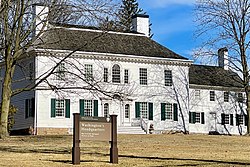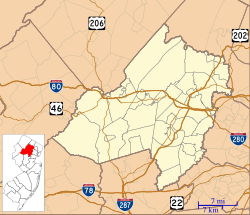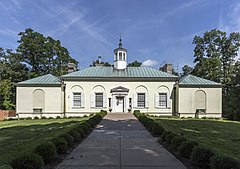
Morris County is a county located in the U.S. state of New Jersey, about 30 mi (48 km) west of New York City. According to the 2020 census, the county was the state's tenth-most populous county, with a population of 509,285, its highest decennial count ever and an increase of 17,009 (3.5%) from the 492,276 counted at the 2010 census. Morris County is part of the New York metropolitan area and is divided into 39 municipalities, with many commuter towns but no large cities. Its county seat is Morristown, in the southeast. The most populous place was Parsippany-Troy Hills Township, with 56,162 residents at the time of the 2020 census, while Rockaway Township covered 45.55 square miles (118.0 km2), the largest total area of any municipality.

Morristown is a town and the county seat of Morris County, in the U.S. state of New Jersey. Morristown has been called "the military capital of the American Revolution" because of its strategic role in the war for independence from Great Britain. Today this history is visible in a variety of locations throughout the town that collectively make up Morristown National Historical Park.
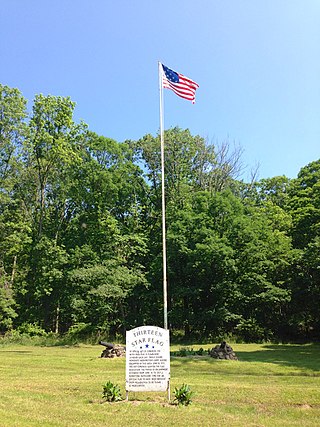
"Middlebrook encampment" may refer to one of two different seasonal stays of the Continental Army in central New Jersey near the Middlebrook in Bridgewater Township in Somerset County. They are usually differentiated by either the date of the encampment or their chronological order.
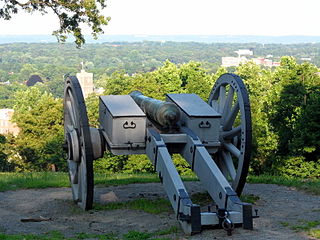
Fort Nonsense is one of four sites comprising the Morristown National Historical Park, in Morristown, Morris County, New Jersey, United States. Two other sites in Morris County are the Ford Mansion and Jockey Hollow. The fourth is the New Jersey Brigade Encampment Site in Bernardsville, Somerset County.

The Wallace House is a Georgian style historic house, which served as the headquarters of General George Washington during the second Middlebrook encampment (1778–79), located at 38 Washington Place, Somerville, Somerset County, New Jersey, United States. It was added to the National Register of Historic Places on December 2, 1970.

Jockey Hollow is the name for an area in southern Morris County, New Jersey farmed in the 18th century by the Wick, Guerin and Kemble families. The origin of the name is still uncertain, but was used as such at the time of the American Revolution. For most of the Revolutionary War, it was used by portions of Continental Army as a winter camp site, and it housed the main Continental Army during the "Hard Winter" of 1779–80, believed to be the harshest winter in recorded history.

The Ford Mansion, also known as Washington's Headquarters, is a classic 18th-century American home located at 30 Washington Place in Morristown, New Jersey that served as General George Washington's headquarters from December 1779 to June 1780 during the American Revolutionary War.

The Somerset Hills is known as the northern region of Somerset County located in the U.S. state of New Jersey and includes the municipalities of Bedminster, Bernardsville, Bernards Township, Far Hills, Peapack & Gladstone. The Morris County communities of the Chesters and the Mendhams are often considered part of the Somerset Hills.

Acorn Hall is an 1853 Victorian Italianate mansion located at 68 Morris Avenue in Morristown, Morris County, New Jersey. It was added to the National Register of Historic Places on April 3, 1973, for its significance in architecture. It serves as the headquarters of the Morris County Historical Society, which operates Acorn Hall as a historic house museum.
The Pluckemin Continental Artillery Cantonment Site in Pluckemin, New Jersey, at the southern section of Bedminster Township, New Jersey, holds historic American Revolutionary War importance as the Continental Army's artillery winter cantonment during the winter of 1778–79. It was nestled on the western side of the Second Watchung Mountain just to the North of the village of Pluckemin. The major significance of the site lies with the very different picture it yields of military organization during the Revolutionary War, although some point to it as the birthplace of the American military academy, 24 years prior to the founding of the United States Military Academy at West Point.

The Patriots' Path is a multi-use trail system in Morris County, New Jersey, open to cyclists, hikers, and horseback riders, consisting of a 55-mile (89 km) main trail and 35 miles (56 km) of spur trails. The main trail is marked with white blazes or a white circular blaze with a brown tree. The spur trails are marked with blue blazes or a white circle with a blue tree, while the side spur trails are marked with a red blaze or a white circle with a red tree.
Temperance Wick, also known as Tempe Wick and Tempe, was an American Revolutionary War heroine and the subject of many early American legends. She is traditionally regarded as an example of female patriotism in the early Republic, though many scholars and historians dispute the historical accuracy of the stories and traditions surrounding her life.

The New Jersey Brigade Encampment Site, also called the New Jersey Brigade Area, was used by the Continental Army in the winter of 1779–80, during the American Revolutionary War. The site is located in Bernardsville, Somerset County, New Jersey and extends into Harding Township, Morris County. About 1,300 men of the New Jersey Brigade were encamped here. It is one of four contributing sites of the Morristown National Historical Park. The Cross Estate Gardens property was added in 1975.
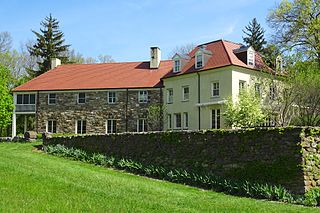
Cross Estate Gardens, containing both formal and native plant gardens, is located at 61 Jockey Hollow Road, Bernardsville, Somerset County, New Jersey. It is on the New Jersey Brigade Encampment Site of the Morristown National Historical Park. The property was acquired in 1975 by the National Park Service.

The Tempe Wick Road–Washington Corners Historic District is a 353-acre (143 ha) historic district located in Harding Township and Mendham Township in Morris County, New Jersey. It extends along Tempe Wick Road from Mount Kemble Avenue to Cold Hill Road, and short segments of Corey Lane, Cemetery Road, Kennaday Road, Leddell Road, and Jockey Hollow Road. Tempe Wick Road is named for Temperance Wick. The district was added to the National Register of Historic Places on August 25, 2000, for its significance in architecture and military history. The district includes 44 contributing buildings, 6 contributing sites, 10 contributing structures, and 4 contributing objects.
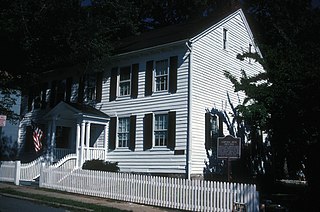
The Dr. Jabez Campfield House, also known as the Schuyler Hamilton House, is a historic, two-story, braced timber-frame colonial Georgian-style house and museum located at 5 Olyphant Place, Morristown, New Jersey.
Dr. Jabez Campfield was a colonial-era doctor, one of the earliest to set up practice in Morristown, New Jersey. He served as a surgeon in the Continental Army during the American Revolutionary War. During the Continental Army's winter encampment in Morristown in 1777, Dr. Campfield helped inoculate soldiers against a smallpox outbreak that spread through the army and the area that winter. Dr. Campfield was a surgeon on the Sullivan Expedition in upstate New York in the summer and autumn of 1779, during which he kept a detailed diary which has been preserved and published. During the winter encampment of 1779-1780, surgeon general Dr. John Cochran stayed in Dr. Campfield's home, and his home served as a "flying hospital". Dr. Cochran's niece, Elizabeth Schuyler, came to stay in Dr. Campfield's home, and while there fell in love and became engaged to Founding Father Alexander Hamilton.

Fosterfields, also known as Fosterfields Living Historical Farm, is a 213.4-acre (86.4 ha) farm and open-air museum at the junction of Mendham and Kahdena Roads in Morris Township, New Jersey. The oldest structure on the farm, the Ogden House, was built in 1774. Listed as the Joseph W. Revere House, Fosterfields was added to the National Register of Historic Places on September 20, 1973, for its significance in art, architecture, literature, and military history. The museum portrays farm life circa 1920.

Franklin Corners is an unincorporated community located along the Passaic River at the intersection of County Route 613 and U.S. Route 202 in Bernards Township of Somerset County, New Jersey. In the 19th century, it had a grist mill, saw mill, general store, school, and several houses. The Franklin Corners Historic District, featuring Van Dorn's Mill, was listed on the National Register of Historic Places in 1975.

George Washington is an outdoor equestrian statue by the American sculptor Frederick Roth located near the Ford Mansion, Washington's Headquarters, in Morristown, New Jersey, United States. It was commissioned by philanthropist E. Mabel Clark to commemorate General George Washington's importance to the history of the city. The bronze sculpture was dedicated on October 19, 1928, the anniversary of the surrender of British General Charles Cornwallis at Yorktown in 1781.
